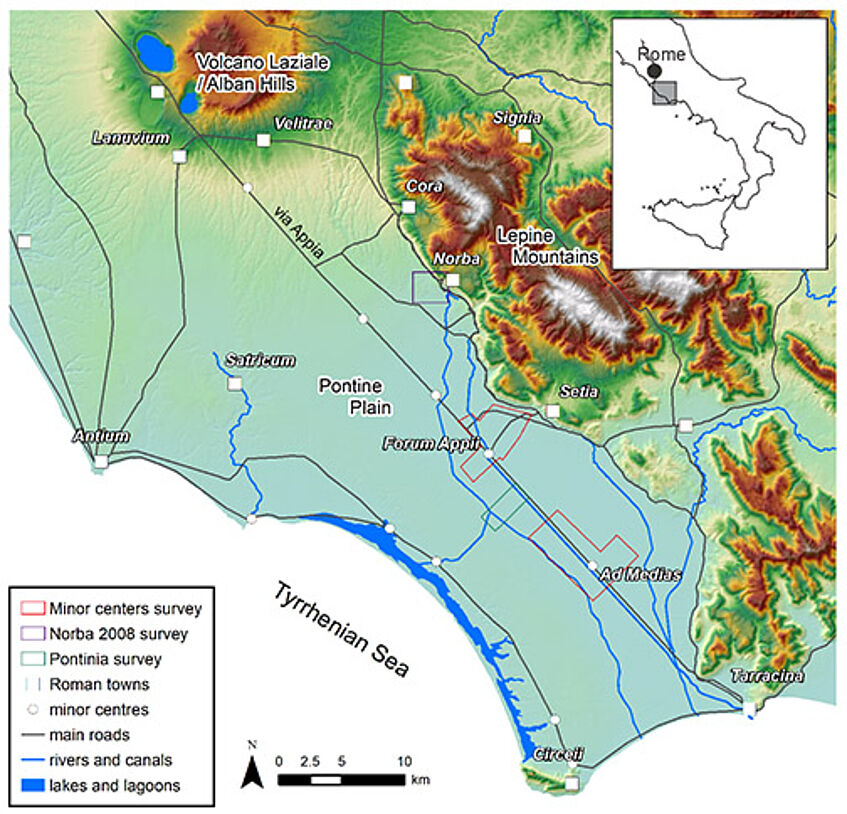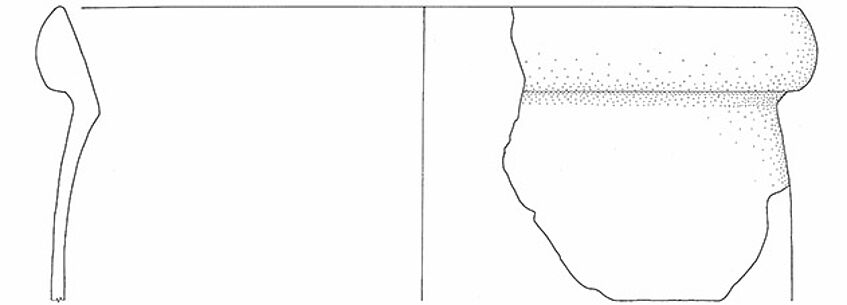Cooking ware as Indicator for Regional Trade: A View from 4th-1st c. BC Central Mediterranean
Project affiliation: Institut für Klassische Archäologie
Project leader: Dr Barbara Borgers
Co-applicant: Univ.-Prof Dr Verena Gassner
Cooperation partners:
Univ.-Prof Dr Rainer Abart, Department of Lithospheric Research, University of Vienna, Austria
Univ.-Prof Dr Theodoros Ntaflos, Department of Lithospheric Research, University of Vienna
Univ.-Prof Dr Corina Ionescu, Geology Department, Babeş-Bolyai University, Romania
Dr Antonio Ferrandes, Scienze dell'Antichità, Sapienza Università di Roma
Dr Francesca Diosono Ludwig-Maximilians-Universität München
Dr. Agnese Fischetti, Royal Netherlands Institute in Rome
Dr Bert Nijboer, Institute of Archaeology, University of Groningen, the Netherlands
Ass. Prof Dr Tymon de Haas, Institute of Archaeology, University of Groningen, the Netherlands
Senior Lecturer Dr Gijs Tol, School of Historical and Philosophical Studies, University of Melbourne, Australia
Supporting institutions and people:
Museo dell’Agro Pontino, Antiquarium Comunale di Nettuno, Museo archeologico di Albano, Soprintendenza Archeologia del Lazio e dell’Etruria Meridionale, Royal Netherlands Institute in Rome (Agnese Fischetti), Sapienza Università di Roma (Antonio Ferrandes, Matilde Fortunato), Groningen Institute of Archaeology (Tymon de Haas, Bert Nijboer, Gert van Oortmerssen), University of Melbourne (Gijs Tol), University of Amsterdam (Jan Sevink), Babeş-Bolyai University (Corina Ionescu).
Financial support: Austrian Science Fund FWF Project T-1085 G
Duration: October 2019 – September 2024
Abstract of the project
The Pontine region is located c. 60 km southwest of Rome on the Tyrrhenian coast and is bounded by the Lepine Mountains and Alban Hills to the east and north, respectively (Fig. 1). In the 4th c. BC, the region was annexed by Rome, and this is visible in the establishment of colonies, such as Norba and Antium, and the construction of the via Appia and roadside settlements, including Forum Appii (Fig. 1). At that time, the region became integrated in a new and wider sphere of interaction, and it played a significant role in the movement of people and objects across the area.
Cooking wares are the most common pottery found on archaeological sites, since they were used in numerous social contexts, including eating, feasting and burial. Their shapes tend to be traditional, with little variation over time. Hence, for their study, fabric analysis is particularly relevant. Consequently, cooking wares are suitable objects for studying trade and exchange networks wherein sites and larger regions participated, and they provide important data for understanding broader socio-political and economic phenomena that underlie their manufacture and distribution.

Figure 1. Map of the Pontine region, Central Italy, situated c. 60 km south of Rome, with indication of three surveys, including Pontinia on the coast, Minor Centres in the inner plain, and Norba in the mountainous area (Map reproduced from Borgers et al. 2017, fig. 1, p. 315: Map by Tymon de Haas ©)
Recent studies on Mid- and Late Republican (4th to 1st c. BC) cooking ware from sites around Rome and Ostia, adopting fabric analysis, indicate the lively movement of this pottery. These studies also show that their mobility increased from the 2nd c. BC towards the dawn of the new era. Following on from this, preliminary work on 4th to 1st c BC cooking ware from the Pontine region (Figs. 2, 3) has highlighted the value of fabric analysis as a means to map regional networks and identify changes therein during that time. The results indicate that the roadside settlements at Forum Appii and Ad Medias, which were located in the inner plain (Fig. 1), were integrated in more regional and inter-regional networks during the Late Republican period compared to the Mid-Republican period. This suggests that pre-existing socio-political and economic relations, wherein those networks were embedded, changed. These new relations were either realigned to older ones, or they were set up from scratch at new trading centres (emporia).

Figure 2. Olla type 2 (Olcese, 2003) cooking vessel with outstanding rim (Drawing reproduced from Borgers et al., 2017, fig. 2, p. 316: Drawing by Gijs Tol ©)
Further work is needed before the nature of regional trade networks of cooking ware in the Pontine region can be understood, as well as the area’s inter-regional connections with the rest of 4th to 1st c. BC Central Italy. Moreover, it is likely that micro-regional differences existed. For instance, one might expect to find that the mountainous area may have had strong links with Rome or Campania, while the coastal area might have tapped into overseas networks. The project will address this by examining 4th to 1st c. BC cooking ware from different site types (domestic/religious) and micro-regions (coast/inner plain/mountains), using fabric analysis, with the aim of tracking the movement of regional products, as well as those from more distant sources. Further to this, the project will address the role of networks and nodes (or hubs) that connected the Pontine region with wider Central Italy as a means to understand underlying power relations and inequality and will illuminate whether and how people’s everyday life in Rome’s hinterland was affected by broader changes during the 4th to 1st c. BC Republic.

Figure 3. Olla type 3a (Olcese, 2003) cooking vessel, with outstanding almond-shaped rim (Drawing reproduced from Borgers et al., 2017, fig. 3, p. 316: Drawing by Gijs Tol ©)
References
- Bertoldi, T. (2011). Ceramiche comuni dal suburbio di Roma. Università di Roma "Tor Vergata" Studi di Archeologia, 1, Roma.
- Borgers, B., Tol, G., De Haas, T. (2018). Reconstructing Production Technology and Consumption Patterns, Using Thin Section Petrography: A Pilot Study of Roman Pottery Production in the Pontine region, Central Italy. Journal of Archaeological Science Reports, 740, 1064-1072.
- Borgers, B., Tol, G., De Haas, T. (2017). Roman cooking vessels (ollae): a preliminary study of the material from the Pontine region, Central Italy. Science and Technology of Archaeological Research, International Symposium on Archaeometry 2016 (Kalamata, Greece), 3 (2), 314-325.
- Capelli, C. (2016). I gruppi mineralogici. In: G. Olcese, C. Coletti, Ceramiche da contesti repubblicani del territorio di Ostia. Immensa Aequora, 4:196-198.
- De Haas, T., Tol, G. (2017). The Economic Integration of Roman Italy, Rural Communities in a Globalising World, Boston.
- Olcese, G., Coletti, C. (2016). Ceramiche da contesti repubblicani del territorio di Ostia (Immensa Aequora, 4). Edizioni Quasar, Roma.
- Olcese, G. (2003). Ceramiche comuni a Roma e in area romana: produzione, circolazione e tecnologia (tarda età repubblicana – prima età imperiale). Mantova, Documenti di Archeologia, 28.
- Olcese, G. (1991). Roman Coarse Ceramics from Albintimilium (Italy): an example of archaeometric and archaeological studies. In: E. Pernicka and G.A. Wagner (eds.), International Symposium in Archaeometry. Heidelberg, 495-504.
- Schuring, J.M. (1986). The Roman, early Medieval and Medieval coarse kitchen wares of the San Sisto Vecchio in Rome: continuity and break in tradition. BABesh, 61: 158-207.
- Spataro, M., Villing, A. (2015). Ceramics, Cuisine and Culture. Oxford, Oxbow Books.
- Thierrin-Michael, G. (2003). Petrographische Charakterisierung und Differenzierung der "römischen Produktion". In: G. Olcese (ed.), Ceramiche Comuni a Roma e in area romana: produzione, circolazione e tecnologia (tarda età repubblicana – prima età imperiale), Documenti di Archeologia, 28, 55-59.
- Tol, G. (2017). From surface find to consumption trend: a ceramic perspective on the economic history of the Pontine region (Lazio, Central Italy) in the Roman period. In T. De Haas, G. Tol (eds.), The Economic Integration of Roman Italy, Rural Communities in a Globalising World, 367-388.
- Tol, G., Borgers, B. (2016). An Integrated Approach to the study of local production and exchange in the lower Pontine Plain. Journal of Roman Archaeology, 29, 349-370.
- Tol, G., De Haas, T., Armstrong, K., Attema, P.A.J. (2014). Minor Centres in the Pontine Plain: the cases of Forum Appii and Ad Medias. Papers of the British School at Rome, 82: 109-134.
